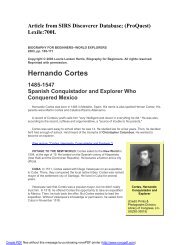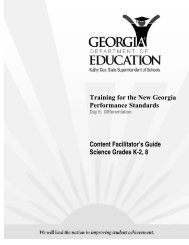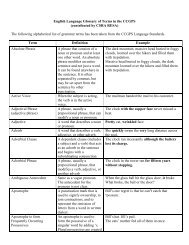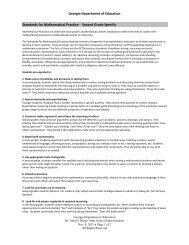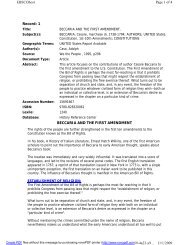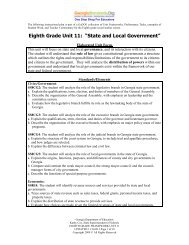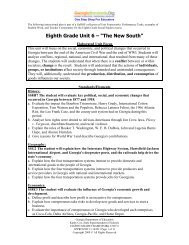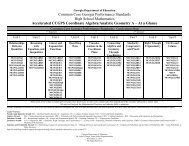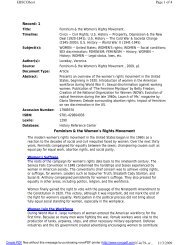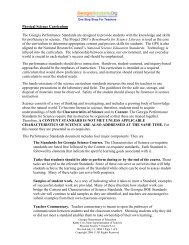Ela ccgps facts and terms at a glance - GeorgiaStandards.org
Ela ccgps facts and terms at a glance - GeorgiaStandards.org
Ela ccgps facts and terms at a glance - GeorgiaStandards.org
You also want an ePaper? Increase the reach of your titles
YUMPU automatically turns print PDFs into web optimized ePapers that Google loves.
ELA CCGPS<br />
FACTS AND TERMS AT A GLANCE<br />
BALANCED LITERACY - ELA K-5 planning templ<strong>at</strong>es <strong>and</strong> units contain the following disclaimer, “This<br />
unit is intended to meet the shared reading <strong>and</strong> writing workshop segments of a balanced literacy<br />
program. Reading found<strong>at</strong>ion st<strong>and</strong>ards (RF), while reinforced in this unit, should be taught directly<br />
during daily guided reading <strong>and</strong> explicit phonics instruction.” Components of a balanced literacy program<br />
should include a scaffolded approach th<strong>at</strong> cre<strong>at</strong>es a gradual release of responsibility from the teacher to<br />
the student for using the following elements:<br />
Direct instruction (read aloud-think aloud <strong>and</strong> modeled mini-lessons for writing)<br />
Shared reading <strong>and</strong> writing<br />
Guided reading <strong>and</strong> writing<br />
Independent practice in reading <strong>and</strong> writing<br />
EXTENDED TEXT - The “extended” in this term means th<strong>at</strong> the study of the text will be revisited<br />
throughout the 9 week period in order to facilit<strong>at</strong>e <strong>and</strong> illustr<strong>at</strong>e wh<strong>at</strong> a deep explor<strong>at</strong>ion of a text entails.<br />
“Extended” does not necessarily mean th<strong>at</strong> the text has more than a certain number of pages, but it does<br />
mean th<strong>at</strong> this text must be complex <strong>and</strong> significant enough in scope th<strong>at</strong> it can serve as an anchor for<br />
repe<strong>at</strong>ed close readings th<strong>at</strong> provide a them<strong>at</strong>ic unity to the unit of instruction.<br />
CLOSE READING - Close reading is a concept th<strong>at</strong> may be understood colloquially or academically <strong>and</strong><br />
so can be defined in different ways. Even in a strictly academic sense, there are varying ideas about wh<strong>at</strong><br />
close reading truly entails. For our purposes in implementing the CCGPS, we consider close reading to<br />
have five levels/elements:<br />
Paraphrase the text sentence by sentence (by chunks)<br />
Summarize a piece of text, paragraph by paragraph<br />
Analyze the text (purpose, questions, inform<strong>at</strong>ion, inferences, concepts, assumptions,<br />
implic<strong>at</strong>ions <strong>and</strong> point of view)<br />
Evalu<strong>at</strong>e the text (clarity, precision, accuracy, logic, breadth, relevance, significance, <strong>and</strong> fairmindedness)<br />
Place yourself in the position of the author; consider another’s perspective by thinking the way the<br />
author might think<br />
The following video provides a good model for close reading:<br />
http://engageny.<strong>org</strong>/resource/close-reading-of-text-mlk-letter-from-birmingham-jail/<br />
ARGUMENTATIVE ESSAY - In their common use as adjectives, the words “persuasive” <strong>and</strong><br />
“argument<strong>at</strong>ive” can be synonymous. In English Language Arts, there are subtle but very important<br />
differences in these two descriptors. Generally speaking, a persuasive essay may focus on emotional<br />
appeals <strong>and</strong> appeals to authority (p<strong>at</strong>hos <strong>and</strong> ethos), using rhetorical str<strong>at</strong>egies not primarily based in the<br />
cit<strong>at</strong>ion of <strong>facts</strong> or factual evidence. Argument<strong>at</strong>ive essays <strong>and</strong> formal deb<strong>at</strong>e tend to depend more<br />
heavily on the cit<strong>at</strong>ion of established <strong>facts</strong> (logos), <strong>and</strong> so are more text <strong>and</strong> research-based <strong>and</strong> depend<br />
on slightly more sophistic<strong>at</strong>ed rhetorical str<strong>at</strong>egies to affect a strong response from the reader or listener.<br />
ESSENTIAL QUESTION - Essential questions are “important questions th<strong>at</strong> recur throughout all our<br />
lives.” They are “broad in scope <strong>and</strong> timeless by n<strong>at</strong>ure. Essential questions refer to “core ideas <strong>and</strong><br />
inquiries within a discipline.” They “point to the core of big ideas in a subject <strong>and</strong> to the frontiers of<br />
technical knowledge. They are historically important <strong>and</strong> alive in the field.” Essential questions help<br />
“students effectively inquire <strong>and</strong> make sense of important but complic<strong>at</strong>ed ideas, knowledge, <strong>and</strong> knowhow<br />
— a bridge to findings th<strong>at</strong> experts may believe are settled but learners do not yet grasp or see as<br />
valuable.” Essential questions “will most engage a specific <strong>and</strong> diverse set of learners.” They “hook <strong>and</strong><br />
hold the <strong>at</strong>tention of your students.” (from Wiggins <strong>and</strong> McTighe)
Examples of effective Essential Questions:<br />
Must a story have a beginning, middle, <strong>and</strong> end?<br />
Must a story have heroes <strong>and</strong> villains?<br />
Do we always mean wh<strong>at</strong> we say <strong>and</strong> say wh<strong>at</strong> we mean?<br />
EVIDENCE – Facts, figures, details, quot<strong>at</strong>ions, or other sources of d<strong>at</strong>a <strong>and</strong> inform<strong>at</strong>ion th<strong>at</strong> provide<br />
support for claims or an analysis <strong>and</strong> th<strong>at</strong> can be evalu<strong>at</strong>ed by others; should appear in a form <strong>and</strong> be<br />
derived from a source widely accepted as appropri<strong>at</strong>e to a particular discipline, as in details or quot<strong>at</strong>ions<br />
from a text in the study of liter<strong>at</strong>ure <strong>and</strong> experimental results in the study of science.<br />
FOCUSED QUESTION – A query narrowly tailored to task, purpose, <strong>and</strong> audience, as in a research<br />
query th<strong>at</strong> is sufficiently precise to allow a student to achieve adequ<strong>at</strong>e specificity <strong>and</strong> depth within the<br />
time <strong>and</strong> form<strong>at</strong> constraints.<br />
FORMAL ENGLISH – See St<strong>and</strong>ard English<br />
GENERAL ACADEMIC WORDS AND PHRASES/VOCABULARY – Vocabulary common to written texts<br />
but not commonly a part of speech. Common Core places general vocabulary into three tiers, defined as<br />
follows:<br />
Tier One words are the words of everyday speech usually learned in the early grades, albeit not<br />
<strong>at</strong> the same r<strong>at</strong>e by all children. They are not considered a challenge to the average n<strong>at</strong>ive<br />
speaker, though English language learners of any age will have to <strong>at</strong>tend carefully to them. While<br />
Tier One words are important, they are not the focus of this discussion.<br />
Tier Two words (wh<strong>at</strong> the St<strong>and</strong>ards refer to as general academic words) are far more likely to<br />
appear in written texts than in speech. They appear in all sorts of texts: inform<strong>at</strong>ional texts (words<br />
such as rel<strong>at</strong>ive, vary, formul<strong>at</strong>e, specificity, <strong>and</strong> accumul<strong>at</strong>e), technical texts (calibr<strong>at</strong>e, itemize,<br />
periphery), <strong>and</strong> literary texts (misfortune, dignified, faltered, unabashedly). Tier Two words often<br />
represent subtle or precise ways to say rel<strong>at</strong>ively simple things—saunter instead of walk, for<br />
example. Because Tier Two words are found across many types of texts, they are highly<br />
generalizable.<br />
Tier Three words (wh<strong>at</strong> the St<strong>and</strong>ards refer to as domain-specific words) are specific to a domain<br />
or field of study (lava, carburetor, legisl<strong>at</strong>ure, circumference, aorta) <strong>and</strong> key to underst<strong>and</strong>ing a<br />
new concept within a text. Because of their specificity <strong>and</strong> close ties to content knowledge, Tier<br />
Three words are far more common in inform<strong>at</strong>ional texts than in liter<strong>at</strong>ure. Recognized as new<br />
<strong>and</strong> “hard” words for most readers (particularly student readers), they are often explicitly defined<br />
by the author of a text, repe<strong>at</strong>edly used, <strong>and</strong> otherwise heavily scaffolded (e.g., made a part of a<br />
glossary).<br />
For more inform<strong>at</strong>ion on identifying tiers of vocabulary go to the following site:<br />
http://www.corest<strong>and</strong>ards.<strong>org</strong>/assets/Appendix_A.pdf<br />
Pages 33-34<br />
INDEPENDENT(LY) – A student performance done without scaffolding from a teacher, other adult, or<br />
peer; in the St<strong>and</strong>ards, often paired with proficient(ly) to suggest a successful student performance done<br />
without scaffolding; in the Reading st<strong>and</strong>ards, the act of reading a text without scaffolding, as in an<br />
assessment.<br />
MORE SUSTAINED RESEARCH PROJECT – An investig<strong>at</strong>ion intended to address a rel<strong>at</strong>ively<br />
expansive query using several sources over an extended period of time, as in a few weeks of instructional<br />
time.
POINT OF VIEW – Chiefly in literary texts, the narr<strong>at</strong>ive point of view (as in first- or third-person<br />
narr<strong>at</strong>ion); more broadly, the position or perspective conveyed or represented by an author, narr<strong>at</strong>or,<br />
speaker, or character.<br />
PRINT OR DIGITAL (TEXTS, SOURCES) – Sometimes added for emphasis to stress th<strong>at</strong> a given<br />
st<strong>and</strong>ard is particularly likely to be applied to electronic as well as traditional texts; the St<strong>and</strong>ards are<br />
generally assumed to apply to both.<br />
PROFICIENT(LY) – A student performance th<strong>at</strong> meets the criterion established in the St<strong>and</strong>ards as<br />
measured by a teacher or assessment; in the St<strong>and</strong>ards, often paired with independent(ly) to suggest a<br />
successful student performance done without scaffolding; in the Reading st<strong>and</strong>ards, the act of reading a<br />
text with comprehension; see also independent(ly), scaffolding.<br />
REVISING – A part of writing <strong>and</strong> preparing present<strong>at</strong>ions concerned chiefly with a reconsider<strong>at</strong>ion <strong>and</strong><br />
reworking of the content of a text rel<strong>at</strong>ive to task, purpose, <strong>and</strong> audience; compared to editing, a largerscale<br />
activity often associ<strong>at</strong>ed with the overall content <strong>and</strong> structure of a text; see also editing, rewriting.<br />
REWRITING – A part of writing <strong>and</strong> preparing present<strong>at</strong>ions th<strong>at</strong> involves largely or wholly replacing a<br />
previous, uns<strong>at</strong>isfactory effort with a new effort, better aligned to task, purpose, <strong>and</strong> audience, on the<br />
same or a similar topic or theme; compared to revising, a larger-scale activity more akin to replacement<br />
than refinement; see also editing, revising.<br />
SCAFFOLDING – Temporary guidance or assistance provided to a student by a teacher, another adult,<br />
or a more capable peer, enabling the student to perform a task he or she otherwise would not be able to<br />
do alone, with the goal of fostering the student’s capacity to perform the task on his or her own.<br />
SHORT RESEARCH PROJECT – An investig<strong>at</strong>ion intended to address a narrowly tailored query in a<br />
brief period of time, as in a few class periods or a week of instructional time.<br />
SOURCE – A text used largely for inform<strong>at</strong>ional purposes, as in research.<br />
STANDARD ENGLISH – In the St<strong>and</strong>ards, the most widely accepted <strong>and</strong> understood form of expression<br />
in English in the United St<strong>at</strong>es; used in the St<strong>and</strong>ards to refer to formal English writing <strong>and</strong> speaking; the<br />
particular focus of Language st<strong>and</strong>ards 1 <strong>and</strong> 2.<br />
GRAMMAR - In the ELA CCGPS Language str<strong>and</strong>, grade level specific skills for conventions <strong>and</strong> usage<br />
are explicitly st<strong>at</strong>ed. However, it is intended th<strong>at</strong> these skills are taught within the context of mentor texts<br />
<strong>and</strong> mini-lessons <strong>and</strong> then applied by students in writing <strong>and</strong> speaking. The st<strong>and</strong>ards are written with<br />
integr<strong>at</strong>ion in mind, so th<strong>at</strong> students hear, read, write about, <strong>and</strong> converse using grade appropri<strong>at</strong>e<br />
grammar. Drill <strong>and</strong> practice of skills in isol<strong>at</strong>ion will not meet the expect<strong>at</strong>ions of the Common Core<br />
language st<strong>and</strong>ards.<br />
INFORMATIONAL TEXTS - Inform<strong>at</strong>ional text is any non-fiction text. This could include essays such as<br />
those by Mark Twain, Jack London, or David Sedaris. It can also include memoir, biography, <strong>and</strong><br />
autobiography. Newspapers, magazines, <strong>and</strong> professional journals are good sources of inform<strong>at</strong>ional<br />
text, as is literary criticism. Instruction, directions, recipes, <strong>and</strong> other types of texts found in daily life can<br />
also be instructive as inform<strong>at</strong>ional text. One half of all texts read in ELA class (K-8) should be<br />
inform<strong>at</strong>ional text. This is not intended to discount the extremely important place of liter<strong>at</strong>ure (drama,<br />
novels, poems, etc.) in the ELA classroom. Inform<strong>at</strong>ional texts should flow <strong>and</strong> connect n<strong>at</strong>urally with the<br />
themes of the literary choices, enhancing students’ enjoyment <strong>and</strong> underst<strong>and</strong>ing of all texts.<br />
RIGOR AND EXPECTATIONS - When Common Core talks about rigor, it is usually understood to mean<br />
cognitive dem<strong>and</strong> <strong>and</strong> complexity. The following chart provides good benchmarks for recognizing levels<br />
of cognitive dem<strong>and</strong> (from Norman L. Webb, Wisconsin Center for Educ<strong>at</strong>ion Research,<br />
http://facstaff.wcer.wisc.edu/normw/ )
DOK LEVEL DOK DEFINITION DOK EXAMPLES<br />
DOK-1 – Recall &<br />
Reproduction<br />
DOK-2 - Basic<br />
Applic<strong>at</strong>ion of<br />
Skills/Concepts<br />
DOK-3 - Str<strong>at</strong>egic<br />
Thinking<br />
DOK-4 - Extended<br />
Thinking<br />
Recall of a fact, term, principle,<br />
concept, or perform a routine<br />
procedure.<br />
Use of inform<strong>at</strong>ion, conceptual<br />
knowledge, select appropri<strong>at</strong>e<br />
procedures for a task, two or<br />
more steps with decision points<br />
along the way, routine problems,<br />
<strong>org</strong>anize/display d<strong>at</strong>a,<br />
interpret/use simple graphs.<br />
Requires reasoning, developing a<br />
plan or sequence of steps to<br />
approach problem; requires some<br />
decision making <strong>and</strong> justific<strong>at</strong>ion;<br />
abstract, complex, or non-routine;<br />
often more than one possible<br />
answer.<br />
An investig<strong>at</strong>ion or applic<strong>at</strong>ion to<br />
real world; requires time to<br />
research, problem solve, <strong>and</strong><br />
process multiple conditions of the<br />
problem or task; non-routine<br />
manipul<strong>at</strong>ions, across<br />
disciplines/content areas/multiple<br />
sources.<br />
Recall elements <strong>and</strong> details of story;<br />
structure, such as sequence of events,<br />
character, plot <strong>and</strong> setting; Conduct basic<br />
m<strong>at</strong>hem<strong>at</strong>ical calcul<strong>at</strong>ions; Label loc<strong>at</strong>ions<br />
on a map; Represent in words or diagrams<br />
a scientific concept or rel<strong>at</strong>ionship.<br />
Perform routine procedures like measuring<br />
length or using punctu<strong>at</strong>ion marks<br />
correctly; Describe the fe<strong>at</strong>ures of a place<br />
or people.<br />
Identify <strong>and</strong> summarize the major events<br />
in a narr<strong>at</strong>ive; Use context cues to identify<br />
the meaning of unfamiliar words; Solve<br />
routine multiple-step problems; Describe<br />
the cause/effect of a particular event;<br />
Identify p<strong>at</strong>terns in events or behavior;<br />
Formul<strong>at</strong>e a routine problem given d<strong>at</strong>a<br />
<strong>and</strong> conditions; Organize, represent <strong>and</strong><br />
interpret d<strong>at</strong>a.<br />
Support ideas with details <strong>and</strong> examples;<br />
Use voice appropri<strong>at</strong>e to the purpose <strong>and</strong><br />
audience; Identify research questions <strong>and</strong><br />
design investig<strong>at</strong>ions for a scientific<br />
problem; Develop a scientific model for a<br />
complex situ<strong>at</strong>ion; Determine the author's<br />
purpose <strong>and</strong> describe how it affects the<br />
interpret<strong>at</strong>ion of a reading selection; Apply<br />
a concept in other contexts.<br />
Conduct a project th<strong>at</strong> requires specifying<br />
a problem, designing <strong>and</strong> conducting an<br />
experiment, analyzing its d<strong>at</strong>a, <strong>and</strong><br />
reporting results/solutions; Apply<br />
m<strong>at</strong>hem<strong>at</strong>ical model to illumin<strong>at</strong>e a<br />
problem or situ<strong>at</strong>ion; Analyze <strong>and</strong><br />
synthesize inform<strong>at</strong>ion from multiple<br />
sources; Describe <strong>and</strong> illustr<strong>at</strong>e how
common themes are found across texts<br />
from different cultures; Design a<br />
m<strong>at</strong>hem<strong>at</strong>ical model to inform <strong>and</strong> solve a<br />
practical or abstract situ<strong>at</strong>ion.<br />
TEXT COMPLEXITY AND LEXILE - We recommend the use of a three-pronged approach to evalu<strong>at</strong>ing<br />
text complexity. It is important not to rely on Lexile score in isol<strong>at</strong>ion. The DOE Text Complexity rubric<br />
addresses the three aspects of text complexity required for consider<strong>at</strong>ion in Common Core Appendix B:<br />
qualit<strong>at</strong>ive, quantit<strong>at</strong>ive, <strong>and</strong> reader/task m<strong>at</strong>ch. Each of these three dimensions includes specific relevant<br />
c<strong>at</strong>egories, each of which is listed with a short explan<strong>at</strong>ion to assist users in making the best possible<br />
determin<strong>at</strong>ion. The rubric is available on the CCGPS tab <strong>at</strong> Ge<strong>org</strong>iaSt<strong>and</strong>ards.Org.<br />
THEMATICALLY CONNECTED SHORT TEXTS - Texts both long <strong>and</strong> short should have them<strong>at</strong>ic<br />
connections. See the DOE sample unit frameworks for examples of how these connections are<br />
established.<br />
SEPARATE READING AND ELA INSTRUCTION IN MIDDLE SCHOOL - For schools th<strong>at</strong> have separ<strong>at</strong>e<br />
cohorts for reading <strong>and</strong> ELA instruction, we would recommend a strong collabor<strong>at</strong>ion between the<br />
teachers of those classes in order to integr<strong>at</strong>e the instruction <strong>and</strong> the student performance tasks as much<br />
as possible. A strong element of the CCGPS is the integr<strong>at</strong>ion of reading <strong>and</strong> writing <strong>at</strong> every level. To<br />
separ<strong>at</strong>e these elements of communic<strong>at</strong>ion is not an ideal circumstance for effective instruction. It can<br />
however, be turned to your advantage because you will have more time in your instructional day to deal<br />
with language arts overall. We recommend th<strong>at</strong> instead of separ<strong>at</strong>ing the str<strong>and</strong>s from one another you<br />
simply bring a stronger focus to the reading or writing portion of the skill set as appropri<strong>at</strong>e, but always<br />
integr<strong>at</strong>e them in both classes wherever possible.<br />
STUDENT WRITING/GRADING WRITTEN ASSESSMENTS - Rubrics for grading all types of<br />
assignments in CCGPS are easily cre<strong>at</strong>ed by simply cutting <strong>and</strong> pasting the st<strong>and</strong>ards you wish to<br />
assess into a table th<strong>at</strong> has been cre<strong>at</strong>ed to include a “Does Not Meet,” “Meets,” <strong>and</strong> an “Exceeds”<br />
column. Because of the streamlined n<strong>at</strong>ure of the st<strong>and</strong>ards, they are easy to manipul<strong>at</strong>e <strong>and</strong> several<br />
may be included in a rubric. This method not only enforces the use of the “language of the st<strong>and</strong>ards,” but<br />
also allows you to easily craft rubrics th<strong>at</strong> assess wh<strong>at</strong>ever st<strong>and</strong>ard(s) you may wish to focus on for a<br />
given assignment.<br />
CCGPS dem<strong>and</strong>s a gre<strong>at</strong> deal of student writing. Teachers who have assigned a smaller number of<br />
major writing assignments in order to be able to provide very extensive feedback on each paper may<br />
need to adjust the ways in which they think about th<strong>at</strong> balance. It is important th<strong>at</strong> students have the<br />
opportunity to produce the writing of the types <strong>and</strong> amounts th<strong>at</strong> will be required of them as they move<br />
into college <strong>and</strong> careers. While extensive feedback can <strong>and</strong> should be given on several assignments<br />
throughout the year, some assignments may benefit from several rounds of peer feedback or from being<br />
the focus of a writer’s workshop instead. Some of the major analysis pieces th<strong>at</strong> are required of students<br />
might be presented as multi-modal group present<strong>at</strong>ions. Additionally, you may craft your rubrics so th<strong>at</strong><br />
you narrow the focus on some of the required papers, grading them for specific skill sets.



